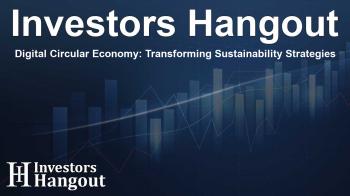Digital Circular Economy: Transforming Sustainability Strategies

Understanding the Digital Circular Economy
The digital circular economy is an innovative approach that merges digital technologies with sustainable practices to create a system where products and materials are reused, refurbished, and recycled efficiently. The goal is to minimize waste while maximizing the life cycle of resources, thus fostering a closed-loop economy.
Key Market Drivers
One of the primary drivers behind the growth of the digital circular economy market is the increasing awareness regarding electronic waste (e-waste). As more individuals and businesses recognize the environmental impact of e-waste, there is a clear shift towards adopting sustainable practices. This heightened awareness is prompting responsible disposal methods for obsolete electronic devices and igniting demand for cutting-edge, eco-friendly solutions. Organizations that actively engage in recycling and refurbishing their electronic products stand to benefit significantly in this evolving landscape.
Another significant contributor to this market's expansion is the advancement of technology. The integration of artificial intelligence (AI), the Internet of Things (IoT), and other digital technologies plays a crucial role in streamlining circular processes. These innovations enable the effective tracking, storage, and analysis of data throughout a product's life cycle, enhancing operational efficiency and promoting sustainable practices.
Opportunities with Refurbished Electronics
The growth of refurbished electronics has opened new avenues within the digital circular economy market. As sustainability becomes increasingly significant in consumer decision-making, the demand for high-quality, pre-owned electronics has soared. Refurbished devices not only present a budget-friendly alternative for consumers but also substantially contribute to reducing e-waste. New and emerging market players have a unique opportunity to cater to eco-conscious consumers seeking reliable and affordable electronic options, further propelling the digital circular economy.
Market Dynamics by Region
European Dominance and Policies
The European region is a frontrunner in the digital circular economy, holding a notable market share of 35.7%. The European Union's initiatives, such as the circular economy action plan, actively promote resource efficiency and sustainable practices across various industries. This supportive environment nurtures business adoption of circular economy models, driving consumer and business commitment to sustainability.
North America’s Rapid Growth
Following Europe, North America stands as the second-largest market with a 33.2% share. Projections indicate a robust growth rate of 24.3% CAGR during the forecast period, fueled by increasing adoption of digital solutions that prioritize sustainability and resource efficiency across numerous sectors.
Technological Innovations Fueling Market Growth
The digital circular economy market is further classified by its offerings which comprise both software solutions and service-based innovations. Software solutions are particularly prominent, exhibiting impressive growth of around 24.3% CAGR. Technologies central to this market segment include blockchain, IoT, and advanced data analytics, facilitating more efficient material tracking, resource optimization, and compliance with circular economy standards.
Strategic Competitive Landscape
As the digital circular economy continues to develop, several competitive players are making their mark. Major names include SAP, IBM, Cisco, and Oracle, all working towards integrating digital strategies that support circular economy initiatives.
Recent Industry Developments
Recent activities include Flex’s acquisition of FreeFlow, targeting the secondary market and enhancing its contribution to the digital circular economy. Additionally, organizations like Imperial are initiating dedicated research labs, further emphasizing the importance of circular economy practices.
Key Highlights of the Market
- Digital resale and reuse is forecasted to be a leading application within the market.
- The automotive vertical remains a dominant player, showcasing a strong CAGR of 23.3%.
- Proactive trends in Europe are expected to sustain significant growth opportunities with an anticipatory CAGR of 3%.
Frequently Asked Questions
What is the digital circular economy?
The digital circular economy combines digital technologies with sustainable practices to maximize the reuse and recycling of products, minimizing waste.
What are the main drivers of the digital circular economy market?
Key drivers include increased e-waste awareness and advancements in technology, such as AI and IoT.
How does refurbished electronics impact the market?
The rise of refurbished electronics creates demand for sustainable options and reduces e-waste, enhancing market growth.
Which regions dominate the digital circular economy market?
Europe leads with a significant market share, followed closely by North America, both showing robust growth potential.
Who are the key players in the market?
Prominent players include SAP, IBM, Cisco, and Oracle, focusing on integrating digital solutions for sustainability.
About Investors Hangout
Investors Hangout is a leading online stock forum for financial discussion and learning, offering a wide range of free tools and resources. It draws in traders of all levels, who exchange market knowledge, investigate trading tactics, and keep an eye on industry developments in real time. Featuring financial articles, stock message boards, quotes, charts, company profiles, and live news updates. Through cooperative learning and a wealth of informational resources, it helps users from novices creating their first portfolios to experts honing their techniques. Join Investors Hangout today: https://investorshangout.com/
Disclaimer: The content of this article is solely for general informational purposes only; it does not represent legal, financial, or investment advice. Investors Hangout does not offer financial advice; the author is not a licensed financial advisor. Consult a qualified advisor before making any financial or investment decisions based on this article. The author's interpretation of publicly available data shapes the opinions presented here; as a result, they should not be taken as advice to purchase, sell, or hold any securities mentioned or any other investments. The author does not guarantee the accuracy, completeness, or timeliness of any material, providing it "as is." Information and market conditions may change; past performance is not indicative of future outcomes. If any of the material offered here is inaccurate, please contact us for corrections.
